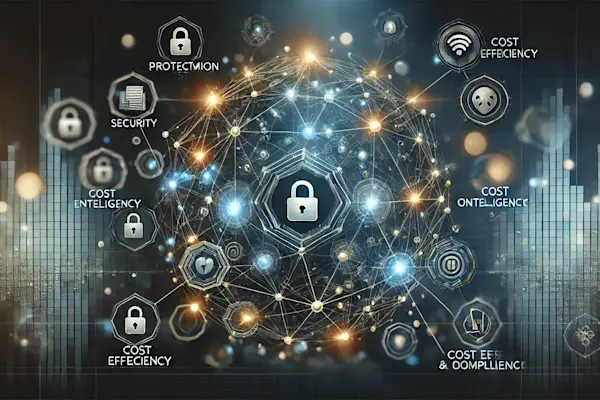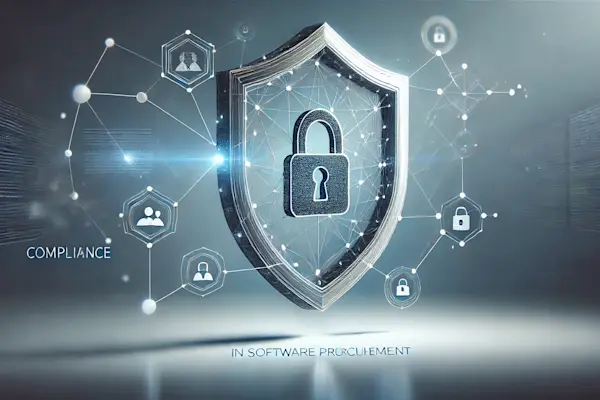
Cybersecurity & Compliance Software
Published on: February 13, 2025
Overview
1. Overview of the Software Category
Definition
Cybersecurity and compliance software helps organizations protect sensitive data, prevent cyber threats, and adhere to regulatory requirements. These solutions include network security, endpoint protection, identity management, compliance tracking, and threat intelligence.
Who Uses It?
IT Security Teams – Detecting and mitigating cyber threats.
Compliance Officers – Ensuring regulatory adherence (GDPR, HIPAA, ISO 27001).
Enterprise Executives – Managing risk and corporate security policies.
Small and Medium Businesses (SMBs) – Protecting customer and company data from cyberattacks.
Why It Matters
Prevents data breaches and financial losses.
Ensures regulatory compliance to avoid legal penalties.
Strengthens business resilience against cyber threats.
Enhances customer trust by safeguarding sensitive information.
2. Key Features to Consider
Must-Have Features
Real-Time Threat Detection & Response – AI-driven cybersecurity intelligence.
Access Control & Identity Management – Role-based permissions and authentication.
Compliance Auditing & Reporting – Automates regulatory documentation and risk assessments.
Data Encryption & Endpoint Security – Protects sensitive information from unauthorized access.
Firewall & Network Security – Monitors and defends against malicious network activity.
Advanced Features
Zero Trust Architecture – Prevents lateral movement in network environments.
Security Information and Event Management (SIEM) – Centralized monitoring and analytics.
Cloud Security & Secure Access Service Edge (SASE) – Securely connects remote workforces.
Automated Threat Hunting & AI-Driven Security – Proactive threat detection.
Dark Web Monitoring & Cyber Threat Intelligence – Identifies compromised credentials and insider threats.
Customization & Integrations
Third-Party Integrations – Connects with existing IT infrastructure.
Scalability & Cloud Readiness – Supports cloud, hybrid, and on-premise environments.
Automated Remediation Workflows – Reduces manual response times for threats.
3. Types of Cybersecurity & Compliance Software and Top Solutions
3.1 Endpoint Security & Threat Detection
| Software | Key Features | G2 Score | Capterra Score | SoftwareAdvice Score | TrustRadius Score | Average Score | Pricing | Website |
|---|---|---|---|---|---|---|---|---|
CrowdStrike Falcon | AI-driven endpoint protection, EDR | 4.8 | 4.7 | 4.6 | 4.7 | 4.7 | Custom | |
Microsoft Defender for Endpoint | Advanced threat analytics, deep integrations | 4.7 | 4.6 | 4.5 | 4.6 | 4.6 | Custom | |
SentinelOne Singularity | AI-based EDR & XDR, real-time remediation | 4.7 | 4.5 | 4.5 | 4.6 | 4.6 | Custom | |
Palo Alto Cortex XDR | Machine learning-powered detection | 4.6 | 4.4 | 4.3 | 4.5 | 4.5 | Custom | |
Symantec Endpoint Protection | Enterprise-grade antivirus & prevention | 4.5 | 4.3 | 4.2 | 4.4 | 4.3 | Custom |
3.2 Identity & Access Management (IAM)
IAM solutions ensure secure access control and identity verification across enterprise systems.
| Software | Key Features | G2 Score | Capterra Score | SoftwareAdvice Score | TrustRadius Score | Average Score | Pricing | Website |
|---|---|---|---|---|---|---|---|---|
Okta Identity Cloud | Multi-factor authentication, SSO | 4.7 | 4.6 | 4.5 | 4.6 | 4.6 | Custom | |
Microsoft Entra ID (Azure AD) | Identity governance, hybrid security | 4.6 | 4.5 | 4.4 | 4.5 | 4.5 | Custom | |
Ping Identity | Adaptive authentication, API security | 4.5 | 4.4 | 4.3 | 4.4 | 4.4 | Custom | |
IBM Security Verify | AI-driven identity analytics | 4.4 | 4.3 | 4.2 | 4.3 | 4.3 | Custom | |
CyberArk | Privileged access management | 4.3 | 4.2 | 4.1 | 4.2 | 4.2 | Custom |
3.3 Security Information & Event Management (SIEM)
SIEM software provides real-time security monitoring, event correlation, and log analysis to detect and respond to threats.
| Software | Key Features | G2 Score | Capterra Score | SoftwareAdvice Score | TrustRadius Score | Average Score | Pricing | Website |
|---|---|---|---|---|---|---|---|---|
Splunk Enterprise Security | Real-time threat detection, analytics | 4.7 | 4.6 | 4.5 | 4.6 | 4.6 | Custom | |
IBM QRadar | AI-powered threat intelligence | 4.6 | 4.5 | 4.4 | 4.5 | 4.5 | Custom | |
LogRhythm NextGen SIEM | Automated incident response | 4.5 | 4.4 | 4.3 | 4.4 | 4.4 | Custom | |
Exabeam Fusion SIEM | Behavior analytics, UEBA | 4.4 | 4.3 | 4.2 | 4.3 | 4.3 | Custom | |
Microsoft Sentinel | Cloud-native SIEM, AI-powered analytics | 4.3 | 4.2 | 4.1 | 4.2 | 4.2 | Custom |
3.4 Cloud Security & Compliance
Cloud security solutions protect cloud environments, ensuring compliance and data integrity.
| Software | Key Features | G2 Score | Capterra Score | SoftwareAdvice Score | TrustRadius Score | Average Score | Pricing | Website |
|---|---|---|---|---|---|---|---|---|
Zscaler Cloud Security | Zero trust, secure cloud access | 4.7 | 4.6 | 4.5 | 4.6 | 4.6 | Custom | |
Palo Alto Prisma Cloud | Cloud workload protection, compliance | 4.6 | 4.5 | 4.4 | 4.5 | 4.5 | Custom | |
Trend Micro Cloud One | AI-based workload security | 4.5 | 4.4 | 4.3 | 4.4 | 4.4 | Custom | |
AWS Security Hub | Compliance monitoring for AWS | 4.4 | 4.3 | 4.2 | 4.3 | 4.3 | Custom | |
Microsoft Defender for Cloud | Multi-cloud security analytics | 4.3 | 4.2 | 4.1 | 4.2 | 4.2 | Custom |
3.5 Regulatory Compliance Management
Regulatory compliance tools help businesses adhere to data protection laws and security policies.
| Software | Key Features | G2 Score | Capterra Score | SoftwareAdvice Score | TrustRadius Score | Average Score | Pricing | Website |
|---|---|---|---|---|---|---|---|---|
OneTrust | GDPR, CCPA compliance automation | 4.7 | 4.6 | 4.5 | 4.6 | 4.6 | Custom | |
Drata | SOC 2, ISO 27001 automated compliance | 4.6 | 4.5 | 4.4 | 4.5 | 4.5 | Custom | |
Vanta | Security compliance monitoring | 4.5 | 4.4 | 4.3 | 4.4 | 4.4 | Custom | |
LogicGate Risk Cloud | Enterprise risk management | 4.4 | 4.3 | 4.2 | 4.3 | 4.3 | Custom | |
Qualys Compliance Suite | Cloud security compliance | 4.3 | 4.2 | 4.1 | 4.2 | 4.2 | Custom |
3.6 Vulnerability Management & Penetration Testing
Vulnerability assessment tools help identify and remediate security weaknesses in IT infrastructure.
| Software | Key Features | G2 Score | Capterra Score | SoftwareAdvice Score | TrustRadius Score | Average Score | Pricing | Website |
|---|---|---|---|---|---|---|---|---|
Tenable Nessus | Vulnerability scanning, network assessment | 4.7 | 4.6 | 4.5 | 4.6 | 4.6 | Custom | |
Rapid7 InsightVM | Continuous vulnerability management | 4.6 | 4.5 | 4.4 | 4.5 | 4.5 | Custom | |
Qualys VMDR | Automated patching, risk prioritization | 4.5 | 4.4 | 4.3 | 4.4 | 4.4 | Custom | |
Acunetix | Web application security testing | 4.4 | 4.3 | 4.2 | 4.3 | 4.3 | Custom | |
Burp Suite Pro | Web security penetration testing | 4.3 | 4.2 | 4.1 | 4.2 | 4.2 | Custom |
4. Pricing Models & Cost Considerations
Common Pricing Structures
Subscription-Based Pricing – Many cybersecurity and compliance solutions follow a monthly or annual subscription model.
One-Time License Fees – Some software vendors provide perpetual licenses with optional renewal costs.
Freemium & Pay-As-You-Go Models – Entry-level solutions offer free plans, with advanced features requiring payment.
Enterprise Custom Pricing – Large organizations often negotiate custom pricing based on specific needs.
Hidden Costs
Implementation & Setup Fees – Custom configurations and initial onboarding costs may apply.
Training & Support – Some vendors charge separately for ongoing training and customer support.
Integration Costs – Additional expenses may arise when integrating with existing IT infrastructure.
Compliance Audit & Certification Fees – Regular audits and compliance testing may require extra investment.
Negotiation Tips
Bundle Security Solutions – Vendors may offer discounts when purchasing multiple cybersecurity tools.
Request Proof-of-Concept Trials – Ensure the software meets business needs before committing.
Negotiate Long-Term Contracts – Multi-year agreements often come with significant discounts.
Clarify Support & Maintenance Costs – Understanding these costs upfront avoids unexpected expenses.
5. How to Choose the Right Software
Step-by-Step Buyer’s Checklist
✅ Define security and compliance goals. ✅ Identify must-have features based on risk assessment. ✅ Shortlist software based on budget and business needs. ✅ Request demos and free trials to evaluate usability. ✅ Consider integrations with existing security infrastructure. ✅ Assess vendor reputation, support, and compliance certifications. ✅ Finalize purchase and implement with a clear rollout strategy.
Common Mistakes to Avoid
Underestimating Cyber Threats – Failing to invest in comprehensive security solutions.
Ignoring Compliance Requirements – Non-compliance with industry regulations can lead to severe penalties.
Overlooking Integration Needs – Ensure the software integrates seamlessly with existing tools.
Focusing Solely on Price – Prioritize security effectiveness over cost-cutting measures.
Skipping User Training – Employees must be educated on security protocols to prevent breaches.
Decision Matrix Template
| Factor | Weight | Option 1 | Option 2 | Option 3 |
|---|---|---|---|---|
Security Features | X% | Score | Score | Score |
Compliance Support | X% | Score | Score | Score |
Integration Capability | X% | Score | Score | Score |
Vendor Reputation | X% | Score | Score | Score |
Total Cost of Ownership | X% | Score | Score | Score |
Final Score | 100% | Score | Score | Score |
6. Implementation & Adoption Tips
Best Practices for Rolling Out New Software
Start with a Pilot Program – Test security software with a small team before full deployment.
Develop a Deployment Timeline – Set clear milestones for implementation.
Assign Responsibilities – Ensure IT security teams and compliance officers manage different aspects.
Ensure Business Continuity – Avoid disruptions by planning transition strategies carefully.
How to Get Team Buy-In
Educate Employees on Cybersecurity Risks – Highlight the importance of strong security practices.
Communicate the Benefits – Explain how the software improves security and simplifies compliance.
Provide Hands-On Training – Offer step-by-step user guides and workshops.
Encourage Ongoing Feedback – Continuously assess usability and employee concerns.
Ongoing Maintenance & Optimization
Regular Security Updates – Keep software up to date to mitigate new threats.
Monitor & Analyze Threat Reports – Use analytics to improve security policies.
Conduct Periodic Security Audits – Ensure continued compliance with industry standards.
Adjust Policies as Needed – Cyber threats evolve, and so should security strategies.
7. Conclusion & Next Steps
Cybersecurity & compliance software is essential for modern businesses to protect their infrastructure, meet regulatory requirements, and mitigate evolving threats. By understanding the different categories and evaluating the top solutions, organizations can strengthen their security posture effectively.
For personalized cybersecurity recommendations and consultations, contact us at connect@allcaps.ai.


